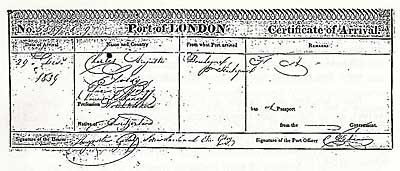Louis Lachenal: “Engineer and Concertina Manufacturer” (Part 1) |
|
|
|
|
Posted 15 January 2004 Louis Lachenal: “Engineer and Concertina Manufacturer” (Part 1)Stephen Chambers
|
||||||||||||||||||||||||||||||||||||||||||||||||||||||||||||||||||||||||||||||||||||||||||||||||||||||||||||||||||||||||||||||||||||||||||||||||||||||||||||||||||||||||||
| COMPASS OF INSTRUMENTS. | SINGLE ACTION |
DOUBLE ACTION | ||||||||||
| Plain. | Plain. | Best. | ||||||||||
| £ | s. | d. | £ | s. | d. | £ | s. | d. | ||||
| Scale from b to d''' | Two Octaves and Two Notes, 32 Keys. |
5 | 15 | 6 | 8 | 8 | 0 | 11 | 0 | 0 | ||
| Scale from b to a''' | Two Octaves and Seven Notes, 40 Keys. |
7 | 0 | 0 | 11 | 0 | 0 | 14 | 0 | 0 | ||
| Scale from g to c'''' | Three Octaves and Three Notes, 48 Keys. |
8 | 8 | 0 | 14 | 0 | 0 | 16 | 16 | 0 | ||
| TENOR CONCERTINA. | ||||||||||||
| Scale, Three Octaves, from c to c''' | 16 Guineas. | |||||||||||
| BASS CONCERTINA. | ||||||||||||
| Scale, Three Octaves, from C to c'' | 16 Guineas. | |||||||||||
The Tenor Concertina is a little larger than the Treble Instrument. The fingering is the same, but the sounds produced are an octave lower.
The Bass Concertina is nearly double the size of the Treble Instrument; it has a single action, the fingering is the same, but the sounds produced are two octaves below those of the treble instrument.
The above Instruments are also made in sets, accurately tuned together, according to the standard pitch, for the performance of Trios, Quartets, &c.
A Case is provided with each Instrument.
Notes
1 The full title is "Recollections of the English Concertina from 1844 by George Jones, born February 29th 1832." I have not had access to his original manuscript, but only to a (silently edited?) transcript in Neil Wayne's Concertina Book: Final Edit (unpublished typescript, 1986), [63-65]. The "Recollections" appear—heavily edited and with commentary by Frank E. Butler and Neil Wayne—as "The Concertina Trade in Victorian Times: An Echo from the Past—Recollections of the English Concertina Trade by George Jones," Free Reed: The Concertina Newsletter 16 (November 1973): 14–20. Here, Wayne gives his source for the "Recollections" as the International Concertina Association Newsletter of September 1855 [sic]. Presumably, the date should read September 1955, but I have not been able to verify this. On Jones, see Butler (and Joel Cowan), "Concertinas in the Commercial Road: The Story of George Jones," Concertina & Squeezebox 20 (Summer 1989):5–14.
[Since this article was written, the original manuscript has appeared in the British Library, catalogued as: Additional Manuscript 71124 Q, Recollections of the manufacture of the English concertina from 1844, by George Jones; [1912]. Presented by F. E. Butler, Esq., grandson of George Jones, 29 Aug. 1988, and incorporated in 1993. ff. 331 x 207mm. Prior to presenting the manuscript to the British Library, Butler had sent a copy to Richard Evans of Concertina Magazine (Australia), who published a transcription in two parts in Concertina Magazine 13 (Winter 1985): 4–5, and 14 (Spring 1985): 4–7. This publication is available online as George Jones, "Recollections".] [ Back to text ]
2 The short biographical sketch that follows is taken from an unsigned article, "Men We Have Met: George Jones," Musical Opinion & Music Trade Review 88 (1 January 1885):203. [ Back to text ]
3 The instrument is better known today as the "flutina." [ Back to text ]
4 Jabez Austin, described on his death certificate (21 July 1857) as a "master carpenter"; Austin "made the [reed] pans complete for Wheatstone … all done by hand, outdoor"; see Jones, "Recollections," [63]. [ Back to text ]
5 Joseph Scates, reed-maker and tuner, worked for Wheatstone's before starting his own concertina manufactury in 1844. [ Back to text ]
6 This was in 1844, when Jones was only twelve years old; see Jones, "Recollections," [63]. [ Back to text ]
7 This must have been in 1850. Jones, who carried on the business after the untimely death of Austin at age forty-two in 1857, claimed—in a George Jones & Sons catalogue of circa 1890—that the firm was "Established 1850"; see also, Jones's "Directions for Repairs" card (S. Chambers Collection) and numerous advertisements. [ Back to text ]
8 Wayne, Concertina Book, [63], dubs the "Recollections": "The George Jones 'Memoir' of 1913." He offers no evidence for dating the "Recollections" from that year, and other references to them give no specific date. Wayne states that they were "wisely preserved for us by his grandson Frank E. Butler. Sadly, Mr. Butler died on 21 February 1992, and I do not know what has become of the original manuscript. [ Back to text ]
9 See Richard Carlin, "An Interview with Harry Crabb," in English Concertina (New York: Oak Publications, 1977), 54-56. [ Back to text ]
10 I am indebted to Ms. R. A. (Robina) Phillips for most of my information about Charles Crabb's family. She is a great-great-granddaughter of Charles Crabb (1835-1885); her great-grandmother was his daughter, Elizabeth Mary (1861-1921), who married a fellow concertina-maker, William Francis North (1857–1944), on Christmas Day, 1879. Elizabeth's sister, Louisa Matilda (1863–1946), was a tuner of concertinas. Finally, Ms. Phillips has written a thesis entitled "Great Great Grandfather, Concertina Maker," presented for the University of London Diploma in the History of the Family (1 June 1990). [ Back to text ]
11 Concertina Book, [70]. [ Back to text ]
12 On the partners in Lachenal & Co., Sanders and Ballinger, see Wayne, "The Tommy Williams Interview—Part 2," and "The Tommy Williams Story—Part 3," Free Reed: The Concertina Newsletter 5 (May 1972): 7, and (August 1972): 12, respectively (see note 13). Of the two partners, Williams notes that "Sanders had the bigger share; he owned the property." [ Back to text ]
13 Williams was interviewed by Neil Wayne in 1968; transcripts from this interview were published in three installments in Free Reed: The Concertina Newsletter, under various titles: "Tommy Williams," 3 (January 1972): 5–6; "The Tommy Williams Interview—Part 2," 5 (May 1972): 6–7; and "The Tommy Williams Story—Part 3," 7 (August 1972): 10–12 An edited version appears in the sleeve notes to his LP recording, Tommy Williams–Springtime in Battersea. Free Reed Records, FRR 008 (1976). [ Back to text ]
14 "The Tommy Williams Interview—Part 2," 7. [ Back to text ]
15 "The Tommy Williams Interview—Part 2," 7. [ Back to text ]
16 The references to Jones, Crabb, and Williams refer to the items cited in notes 1, 9, and 13. I have occasionally added or altered punctuation—silently—in order to clarify the sense of the passage. [ Back to text ]
17 Jones can be interpreted in two ways here: either that Hervy and Shaller were already Lachenal's companions when he arrived in England, or that they were simply two fellow-Swiss immigrants who worked with him later. According to Jones, Shaller was a toolmaker whom he (Jones) later employed to make the tooling to build "Anglo" concertinas (c. 1854?). Can it be just coincidence that one of the two servants in the Lachenal household at the time of the 1851 census was named Mary Ann Shaller? Finally, the Dictionnaire historique et biographique de la Suisse (Neuchâtel, 1928) includes entries for the surnames "Hervé" and "Schaller," which may be the correct (or at least the original) spelling of the names. About Hervy I know nothing; perhaps it is an error for Golay (see below). Finally, he should quite obviously not be conflated with the French composer-conductor-singer Florimond Ronger (1825–1892), who had close connections with London's Covent Garden and Empire Theatre in the 1870s–1880s and used "Hervé" as a stage name. [ Back to text ]
18 Public Record Office HO2 74, Nos. 6587, 8, 9 (the final entries for 1839). [ Back to text ]
19 His Census Returns contradict themselves regarding his age. In 1851 (30–31 March), he is stated to be thirty, but in 1861 (7–8 April), he is listed as being thirty-nine (but should have been forty if the 1851 Return is correct). Both Returns agree that he was born in Geneva. The documents are: 1851 Census HO 107/1510 480 (p. 27) and 1861 Census RG 9/192 (p. 25). Finally, his Death Certificate (18 December 1861) gives his age as "40 Years." [ Back to text ]
20 Britten's Old Clocks and Watches and their Makers, 9th ed. (London: Bloomsbury Books, 1990), 458, has the following entries: "GOLAY, Charles A., 1856–75; 35(6) Davies st., Berkeley sq.; watch maker (dir)."; and GOLAY, Eli, 1849–53; 6 Lr. Charles st., Northampton sq. 1849; 19 Spencer st. 1851; 23 Spencer st. 1853; watch maker (dir)." [ Back to text ]
21 Samuel Smiles, Industrial Biography (London:John Murray, 1863), 249–51, 257. The term "mechanic" is an old name for an engineer. [ Back to text ]
22 British Patent No. 9066, 4 September 1841. A Machinery for Cutting Cork." The reference to "Fitchfield" Street in the Patent is problematic, since no street of this name existed. It may be a misprint for Litchfield (as it was then spelled) Street—Lachenal was later to live in King Street, which joined with Litchfield Street—or perhaps Titchfield Street, but I have not been able to trace Lachenal in either of those streets in the 1841 census. Soho was then a very cosmopolitan area of London, full of craftspeople since its settlement by Huguenot refugees starting in the late seventeenth century. It would have had obvious attractions for French-speaking watchmakers and engineers. [ Back to text ]
23 In other words, as "outwork," work done away from the shop or workroom. [ Back to text ]
24 This is the traditional name for the ends or fretwork of the concertina. To judge from the tasks to be carried out, Robert Dowsett must have been a "fancy cabinet maker." Such work more typically consisted of making tea caddies and ladies' work boxes, which were usually rosewood veneered on a deal carcase—just like a concertina case. The surviving "Wages Books" (see below) show that he was paid weekly, usually four or five pounds in 1845–1846 and five, six, or seven pounds in 1848–1849, and that he always signed for his money.
According to Henry Mayhew's letter to the Morning Chronicle (22 August 1850), times had grown hard for fancy cabinet makers during the previous twenty years. One of his informants stated: "I've now been on tea caddies, 12 inch, with raised tops. The materials—rosewood veneers, deal, locks, hinges, glue and polish cost me £1 for the dozen. I must work hard and very long hours, 13 or more a day [seven days a week, with the help of his wife and daughter], to make two dozen a week, and for them I only get, at the warehouse, 28s a dozen. … That's 16s a week for labour." I am sure that Dowsett must have been employing others to be drawing such large sums each week. There is a London directory entry for him in 1852 as a concertina maker (Wayne, Concertina Book, [71]), and another in the Musical Directory, Register and Almanack, 1853, at 18, New Gloster Street, Hoxton. [ Back to text ]
25 According to Jones, "Recollections," [64], James Card later worked for George Case and Keith, Prowse & Co., as well as for Jabez Austin/George Jones. He appears in London directories in 1856 as a concertina bellows maker at 104, Shaftesbury Street and in 1859 as a concertina maker at 63, Son Street (as the street is cited in Wayne, Concertina Book,, [75]). [ Back to text ]
26 Rock Chidley is said to have been a nephew of Charles Wheatstone. The work of a "finisher" would have involved the inspection and final assembly of the parts made by the various specialist craftsmen employed by Wheatstone's. Chidley set up his own business circa 1850, as he appears as a "concertina and musical instrument manufacturer & music publisher, 135, High Holborn" in the Post Office London Directory, 1851. In his prospectus for the Great Exhibition of 1851, he claimed to have inspected nearly three-quarters of Wheatstone's production while he worked there. [ Back to text ]
27 William Dove set up his own short-lived business circa 1849; there are London directory entries for him in 1850–1852 (Wayne, Concertina Book, [67]) and the Musical Directory, Register & Almanack, 1853, at 20, Poland Street, Oxford Street. [ Back to text ]
28 A letter from J. A. Black to the Editor of Musical Opinion & Music Trade Review 208 (1 January 1895), [222], refers to "T. W. Saunders, who, with his father (the first tuner of the concertina, and the first man to produce a free reed in this country) was in the employ of Sir Charles Wheatstone." [ Back to text ]
29 Jones, "Recollections," [63]. [ Back to text ]
30 We see it, for example, on Wheatstone No. 1006, a forty-eight key instrument, sold to Mr. Chappel on 22 November 1845 (S. Chambers Collection). [ Back to text ]
31 British Patent No. 10,041, 8 February 1844: "Improvements on the Concertina and other Musical Instruments, in which the Sounds are Produced by the Action of Wind on Vibrating Springs." [ Back to text ]
32 British Patent No. 5803, 19 June 1829: "A Certain Improvement or Certain Improvements in the Construction of Wind Musical Instruments." Both this patent and the account given in the Quarterly Journal of Science, Literature and Art (April–June, 1830): 397, of Charles Wheatstone's lecture at the Royal Institution, 21 May 1830, give the name of the instrument as Symphonium. However, later sources—including music published for the instrument by Wheatstone & Co.—use the more correct form: Symphonion (italics added). [ Back to text ]
33 See T. A. Blanco White and Robin Jacob, Patents, Trade Marks, Copyright and Industrial Designs (London:Sweet and Maxwell, 1970), 50. [ Back to text ]
34 Scates first appears as "concertina maker" in the 1845 Post Office London Directory, which would have been printed the previous year. It was in 1628 that the Statute of Monopolies established the life of a patent at fourteen years, the term of two apprenticeships. [ Back to text ]
35 These are the small machine screws that clamp the concertina reeds in place on their shoes (reed plates). [ Back to text ]
36 They are accompanied by production books and sales ledgers, the set as a whole being known as the "Red Books." They were preserved by the late Harry Minting, who was Wheatstone's Sales Manager at the time of the move to the Boosey & Hawkes factory and the winding down of the business. Housed for a number of years at the former Concertina Museum, Belper, Derbyshire (under the numbers C1055 and C1056, and cited as such in the literature listed below), they are now at the Horniman Museum, London, where they await cataloguing. On the set of books, see Wayne, "The Wheatstone English Concertina," The Galpin Society Journal 44 (1991): 144–5; Allan W. Atlas, The Wheatstone English Concertina in Victorian England (Oxford: Clarendon Press, 1996), 146; idem, "Who Bought Concertinas in the Winter of 1851? A Glimpse at the Sales Accounts of Wheatstone & Co.," in Music in Nineteenth-Century Britain: Selected Proceedings of the First Conference, ed. Bennett Zon (Aldershot: Ashgate, 1999), 65 and n. 8.
[Since the original publication of this article, the Horniman Museum has completed a project to digitize in full all of these Ledgers and to make them available both on CDs and free on the web at www.horniman.info.] [ Back to text ]
37 Post Office London Directory, 1848. George Yard is now called Dansey Place. It was later rebuilt as a result of the considerable demolition required to drive Shaftesbury Avenue through the district (completed 1886). Princes Street is now known as Wardour Street.
Lachenal's neighbors in George Yard were William Harpur, coachmaker, and Michael Trenklee, music engraver. Interestingly, there was already a link between Wheatstone and Trenklee, since the latter engraved from Wheatstone & Co. some songs by Samuel Godbé (c. 1796–6 May 1841), who performed on the Symphonium in 1830. I have two such songs, Mary Lee and They Knew Me Not in my collection. [ Back to text ]
38 Unfortunately, the Westminster Rate Books shed no light on just when Lachenal moved into George Yard, as the column for "Occupier" is never filled in. [ Back to text ]
39 Including the birth certificates for his children and his 1851 Census Return: "Master Engineer." [ Back to text ]
40 Post Office London Directory, 1866. [ Back to text ]
41 John Nickolds (1787–1862) is listed as a "tool maker" in the 1848 Post Office London Directory, but it is probably significant that he moved to new premises, at 5, Woodbridge Street, Clerkenwell, that year. His directory entries would continue to read "machinist" for the next few years (but so too did Louis Lachenal's) until the entry changes to "Nickolds Bros. concertina ma. [nufacturers]" at the same address in 1854. F. C. Nickolds (son of the above, 1826–1892) & Son advertised in The Concertinist's Guide (London: Howard, [1888]) as "Established 1848," while an advertisement for Nickolds in The Musical Directory, Register & Almanack, 1874, indicates that the firm is "established 26 years." A very interesting "trade card" has survived for a sometime partnership of Nickolds, Crabb & Co. (it probably dates from the period 1860–1864); it reads:
NICKOLDS, CRABB & CO.
MANUFACTURERS OF THE
Improved English Concertina
AND INVENTORS OF THE ANGLO-GERMAN
ESTABLISHED 1848
(Late of Messrs. Wheatstone & Co.)
5, WOODBRIDGE STREET, CLERKENWELL
LONDON
INSTRUMENTS MADE TO ORDER AND TUNED TO ANY PITCH
Concertinas, Flutinas, Accordions &c Tuned & Repaired
ALL KINDS OF MUSICAL INSTRUMENTS SUPPLIED ON THE
LOWEST TERMS
Merchants and Shippers Supplied
The document is reproduced (very indistinctly) in Wayne, The Concertina Museum: An Illustrated Checklist and Historical Introduction (Belper: Free Reed Press, 1986), 70. [ Back to text ]
42 Certificate of Arrival. Public Record Office, HO2 163, Nos. 1868/69. [ Back to text ]
43 She was to change her first name from "Jeanne" to Françoise" on the birth certificates of their children. [ Back to text ]
44 Now part of Shaftesbury Avenue. [ Back to text ]
45 This refers to the "meantone" tuning in which the concertina had fourteen notes per octave, with separate buttons for D sharp/E flat and for G sharp/A flat, and with the E flat and A flat sounding higher than the D sharp and G sharp, respectively. [ Back to text ]
46 Besides naming the pitches, the document notates them on the staff. I use the following octave indications: C, c, c', c'', c''', c'''', in which c' = "middle c." [A scan of this two-page document is available in PDF format, "The Concertina, A New Musical Instrument," promotional brochure and price list (1848), Horniman Museum C824, 2 pages.] [ Back to text ]
Author
Have feedback on this article? Send it to the author.
This original version of this article appeared in
The Free-Reed Journal, Vol. 1 (1999), pp. 7-18.)
© 1999 Stephen Chambers.
Reprinted from the Concertina Library
http://www.concertina.com
© Copyright 2000– by Stephen Chambers
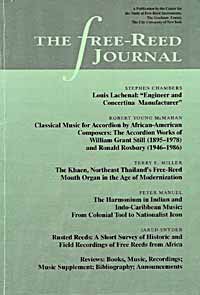
Contents
- Louis Lachenal: “Engineer and Concertina Manufacturer” (Part 1)
- Preamble: The Sources
- The Career of Louis Lachenal
- Notes
This original version of this article appeared in
The Free-Reed Journal, Vol. 1 (1999), pp. 7-18.)
© 1999 Stephen Chambers.
- Original
publication
of this article in PDF format
- Other articles
by Stephen Chambers
Links to related documents
-
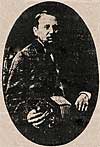 Recollections of the English Concertina, from 1844,
by George Jones, born February 29th 1832
Recollections of the English Concertina, from 1844,
by George Jones, born February 29th 1832
- by George Jones
- A full transcription of a manuscript now in the British Library, catalogued there as: Additional Manuscript 71124 Q, Recollections of the manufacture of the English concertina from 1844, by George Jones; [1912]. Presented by F. E. Butler, Esq., grandson of George Jones, 29 Aug. 1988, and incorporated in 1993. ff. 331 x 207mm. As published in Concertina Magazine, 13 (Winter 1985): 4–5, and 14 (Spring 1985): 4–7. Previously published (with heavy editorial additions) in FreeReed: The Concertina Magazine, No. 16 (November 1973): 14–20. A link is provided to PDF scanned versions of both publications.
- Posted 15 January 2004
- » read full article
- » read 1985 publication in PDF
- » read 1973 publication in PDF
-
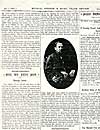 Men We Have Met: George Jones
Men We Have Met: George Jones
- by George Jones
- Historical sketch of the business career of George Jones, published at the time he had just introduced his patent 42-key chromatic Anglo. As published in Musical Opinion & Music Trade Review 88 (1 January 1885):203.
- Posted 15 January 2004
- » read full document in pdf
-
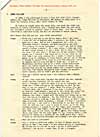 The Tommy Williams Story
The Tommy Williams Story
- by Neil Wayne
- Interview with Tommy Williams, Maccann Duet concertinist and former Lachenal employee. Published in three parts in Free Reed: The Concertina Newsletter, 3 (January 1972): 5–6; 5 (May 1972): 6–7; and 7 (August 1972): 10–12.
- Posted 15 November 2001; last updated 15 January 2004
- » read full document in pdf
-
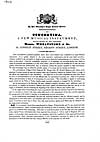 “The Concertina, A New Musical Instrument”
“The Concertina, A New Musical Instrument”
- by Wheatstone & Co.
- Promotional brochure and price list, dated 1848. 2 pages. This copy is in the collection of the Horniman Museum, no. C824.
- Posted 15 January 2004
- » read full document in pdf
-
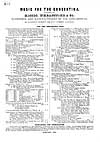 “Music for the Concertina”
“Music for the Concertina”
- by Wheatstone & Co.
- Catalogue of printed music (January 1848, dated 1848. 2 pages. This copy is in the collection of the Horniman Museum, no. C823.
- Posted 15 January 2004
- » read full document in pdf
-
 The Lachenal Sisters Visit Edinburgh, 1865–1866
The Lachenal Sisters Visit Edinburgh, 1865–1866
- by Robert Gaskins
- At Christmas of 1865–1866, three young daughters of the late Louis Lachenal gave a series of concerts in Edinburgh introducing “concerted music” played on treble, tenor, and bass concertinas. We think this was also exactly the period when Lachenal & Co. had lost their contract to manufacture concertinas for Wheatstone, making it important to publicize Lachenal’s own brand. Based on clippings from The Scotsman newspaper, Edinburgh, notices of concerts and reviews, October 1865 through January 1866.
- Posted 01 February 2005
- » read full article
-
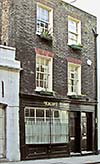 Lachenal & Co.
Lachenal & Co.
- Directory
- Concertina Library directory of all information on this website about Lachenal & Co.
- Posted 01 January 2005
- » go to directory
Send this page to a friend.
This page was last changed | |
|
© Copyright 2000– by Robert Gaskins |

